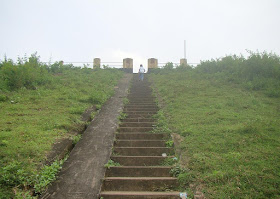Pothundi Dam, Nelliyampathy
Pothundi Dam is an
irrigation dam near Pothundi village in the Palakkad district of Kerala state, India. Constructed in the 19th century, it
is considered one of the oldest dams in India. It provides irrigation to an
area of 5,470 hectares (13,500 acres) in the Palakkad
district and drinking water
supply to the Nemmara, Aylur, and Melarcode Panchayat. A popular festival
held on the shores of the reservoir is known as the Nemmara Vallengi Vela
Festival.
Pothundi is a earth dam
situated in Palakkad District of Kerala State. It was constructed in the 19th
century and is the second dam in Asia which does not use cement mixture for
construction. Pothundi Dam does not have a concrete core at its base which is
mainly found in other dams. Instead of concrete mixture the core is, built
using a mixture of jaggery and quick lime.
Dam is located about 42 km
drive from the Palakkad City. The dam site is a picnic spot for locals and many
other tourists. The lush green environment makes it an ideal picnic spot away
from the city chaos. It was built as a reservoir to serve the water required
for agriculture and drinking purpose in the Chittur taluk.
The dam is built across
the kaivayi of the Ayilurpuzha (Bharathappuzha sub tributary). The
Meenchadypuzha and Padipuzha flows into this reservoir. The reservoir has an
ayacut with 10930 hectares in the Chittur and Alathur taluks of Palakkad.
The beautiful views of
Nelliyampathy Mountains can be seen from Pothundi dam site. The reservoir is
located about 8 km from Nemmara and 42 km from Palakkad city; Nelliampathy
hills is approximately 17 km away. The dam site was the main location for the
Malayalam film Vinodayathra.
The Pothundi dam site
provides a picturesque to the visitors with a back drop of the hill ranges of
Nelliyampathy on one side and acres of green rice fields on the other side.
The spot is an ideal place
to make a stopover on your way to Nelliyampathy to enjoy the beauty of nature
and to unwind yourself.
Overview
Pothundi Reservoir is one
of the important sources of drinking water in the region and is a famous picnic
spot. Tourists can enjoy boating at the reservoir.
It will be really amazing
if you visit Pothundi Dam and Reservoir during Monsoon as the water level will
be more and the greenery also will be cute during this time.
Pothundi Dam is situated
near to the down valley town “Nemmara ". You can also visit a small
beautiful garden over there. Once you reach the right top of the dam through
the entrance, you can see the breathtaking view of Nelliyampathy
Valley on the left side of the Dam and the amazing beauty of paddy fields on
the right side of the Dam, which are amazing.
There are plenty of local
private buses plying to Pothundi Dam from Nemmara. You will never bother about
the road condition as the authority has been maintained it properly without any
gutter.
There is no hotel /
restaurant located in Pothundi Dam area. But you can find better restaurants in
Nemmara, which is hardly 15 minutes drive from Pothundi Reservoir.
Meanwhile fast food and ice cream will be available inside the garden.
You can't find
any ATM center and petrol Bunk in Pothundi Reservoir area. But it
will be available in Nemmara town.
Topography
The dam is built in
the Pothundi village across the Meenichiladipuzha and Padipuzha
rivers, which are tributaries of the Aylampuzha River, about 400 metres
(1,300 ft) upstream of the confluence, in the backdrop of the Nelliampathy
hills. It drains a catchment area of 31 square kilometers (12 sq mi)
at Full Reservoir Level, which is thickly forested with teak
wood trees. The dam is in the Chittur taluk, about 8 kilometers
(5.0 mi) from Nemmara and 42 kilometers (26 mi) from Palakkad and 17 kilometers (11 mi) from Nelliampathy.
History
The dam, built in the 19th
century for irrigation, was developed as a medium irrigation project completed
in 1971 at a cost of Rs.23.425 million. The dam also provides water supply, and
the reservoir has been developed as an important inland fisheries project.
Features
The dam is an earth-filled
structure built to a height of 32.61 metres (107.0 ft) and a length of
1,680 metres (5,510 ft). The gross storage capacity of the reservoir is
50,914,000 m3 (41,277 acre·ft) and the live storage, excluding
dead storage, is 43,900,000 m3 (35,590 acre·ft).
It has a spillway section
to route the designed flood discharge. The irrigation component of the project,
completed in 1971, consists of a 10 kilometers (6.2 mi) long right bank
canal and an 8 kilometers (5.0 mi) left bank canal, which provides
irrigation to an area of 5,465 hectares (13,500 acres) in the Chittur and Alathur taluks.
In view of favorable soil
conditions, the irrigation practice under this project is a rice-based system
in the Palghat plains. The storage from the reservoir is also utilized to the
extent of 15,380,000 m3 (12,469 acre·ft) for providing drinking
water supply to Nemmara and Aylur villages.
Reservoir fishing is well
developed and covers an area of 363 hectares (900 acres). The various species
of river fishes found in the reservoir are murrel, catfish, tilapia, rohu (Labeo rohita), barbus, eel, common
carp (Cyprinus
carpio), mrigal, gourami, and catla.
According to FAO
statistics, the stocking is 1.241 million fingerlings per year with stocking
rate of 684 fingerlings per ha per year. The fisheries development in the
reservoir has been done under the Indo-German Reservoir Fisheries Development
Project. According to the State Fisheries Department, the fish catch was about
7,057 kilograms (15,558 lb) per year during 1992-93 with a yield of 19.4
per ha.
The production units
proposed under this project were brood
fish stock, mini-hatchery, and
rearing components, apart from the pens to be set up in the reservoir periphery
and the floating cages offshore.























